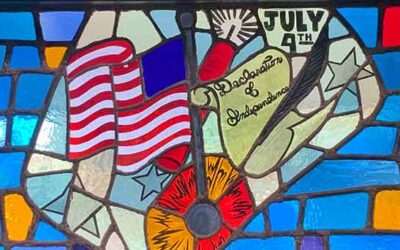Father Nathan
Understanding the Sacred Triduum
Father Nathan | Understanding the Sacred Triduum
The Sacred Triduum:
What exactly is the Triduum?
It literally just means a series of three days. The three holy days of Maundy Thursday, Good Friday and Holy Saturday. As the Catechism of the Catholic Church puts it,
“The kingdom of God enters into our time” (CCC, 1168)
The Mystery of Faith “Beginning with the Easter Triduum as its source of light, the new age of the Resurrection fills the whole liturgical year with its brilliance. Gradually, on either side of this source, the year is transfigured by the liturgy”
(Catechism of the Catholic Church).
The Easter Triduum begins with the Vigil of Holy Thursday. It marks the end of the forty days of Lent and the beginning of the three-day celebration of the death and resurrection of Jesus Christ – Holy Thursday, Good Friday and Easter Vigil/Easter Sunday.
The Fathers of the Second Vatican Council reminded us of the extraordinary significance of the Triduum: “Christ redeemed us all and gave perfect glory to God principally through his paschal mystery: dying he destroyed our death and rising he restored our life. Therefore the Easter Triduum of the passion and resurrection of Christ is the culmination of the entire liturgical year.” (General Norms for the Liturgical Year and the Calendar, # 18)
The Catechism of the Catholic Church instructs us: “Beginning with the Easter Triduum as its source of light, the new age of the Resurrection fills the whole liturgical year with its brilliance. Gradually, on either side of this source, the year is transfigured by the liturgy. It really is a “year of the Lord’s favor.” The economy of salvation is at work within the framework of time, but since its fulfillment in the Passover of Jesus and the outpouring of the Holy Spirit, the culmination of history is anticipated “as a foretaste,” and the kingdom of God enters into our time.
“Therefore Easter is not simply one feast among others, but the “Feast of feasts,” the “Solemnity of solemnities,” just as the Eucharist is the “Sacrament of sacraments” (the Great Sacrament). St. Athanasius calls Easter “the Great Sunday” and the Eastern Churches call Holy Week “the Great Week.” The mystery of the Resurrection, in which Christ crushed death, permeates with its powerful energy our old time, until all is subjected to him.” (CCC #1168, 1169)

Maundy (Holy) Thursday:
The significance of Holy Thursday?
Holy Thursday is the commemoration of the Last Supper of Jesus Christ when he established the sacrament of Holy Communion prior to his arrest and crucifixion.
It also commemorates His institution of the priesthood. The holy day falls on the Thursday before Easter and is part of Holy Week. Jesus celebrated the dinner as a Passover feast. Christ would fulfill His role as the Christian victim of the Passover for all to be saved by His final sacrifice.
The central observance of Holy Thursday is the ritual reenactment of the Last Supper at Mass. This event is celebrated at every Mass, as part of the Liturgy of the Eucharist, but it is specially commemorated on Holy Thursday.
He also establishes the special priesthood for his disciples, which is distinct from the “priesthood of all believers.” Christ washed the feet of his Disciples, who would become the first priests.
This establishment of the priesthood reenacted at Mass with the priest washing the feet of several parishioners.
During the Passover meal, Jesus breaks bread and gives it to his Disciples, uttering the words,
“This is my body, which is given for you.” Subsequently, he passes a cup filled with wine. He then says, “This is my blood…”
It is believed those who eat of Christ’s flesh and blood shall have eternal life.
Holy Thursday celebrates the institution of the Eucharist as the true body and blood of Jesus Christ and the institution of the sacrament of the priesthood.
Around the world, Bishops and priests come together at their local Cathedrals on Holy Thursday morning to celebrate the institution of the priesthood. During the Mass, the bishop blesses the Oil of Chrism that will be used for Baptism, Confirmation, and Anointing of the sick or dying.
At this Mass, the bishop washes the feet of twelve priests to symbolize Christ’s washing of his twelve Apostles, our first bishops and priests.
This Mass stresses the importance Jesus puts on the humility of service, and the need for cleansing with water, a symbol of baptism. Also emphasized are the critical importance of the Eucharist and the sacrifice of Christ’s Body, which we now find present in the consecrated Host.
At the conclusion of the Mass, the faithful are invited to continue Adoration of the Blessed Sacrament throughout the night, just as the disciples were invited to stay up with the Lord during His agony in the garden before His betrayal by Judas.
After Holy Thursday, no Mass will be celebrated again in the Church until the Easter Vigil celebrates and proclaims the Resurrection of the Lord Jesus Christ.

Good Friday:
“‘It is finished’; and he bowed his head and handed over his spirit.”
On Good Friday, the entire Church fixes her gaze on the Cross at Calvary.
Each member of the Church tries to understand at what cost Christ has won our redemption. In the solemn ceremonies of Good Friday, in the Veneration of the Cross, in the chanting of the ‘Reproaches’, in the reading of the Passion, and in receiving the pre-consecrated Host, we unite ourselves to our Savior, and we contemplate our own death to sin in the Death of our Lord.
The Church – stripped of its ornaments, the altar bare, and with the door of the empty tabernacle standing open – is as if in mourning. In the fourth century the Apostolic Constitutions described this day as a ‘day of mourning, not a day of festive joy,’ and this day was called the ‘Pasch (passage) of the Crucifixion.’
The liturgical observance of this day of Christ’s suffering, crucifixion and death evidently have been in existence from the earliest days of the Church.
No Mass is celebrated on this day, but the service of Good Friday is called the Mass of the Presanctified because Communion (in the species of bread) which had already been consecrated on Holy Thursday is given to the people.

Holy Saturday:
The vigil is divided into four parts:
1. Service of Light
2. Liturgy of the Word
3. Liturgy of Baptism
4. Liturgy of the Eucharist
Liturgically, this marks the day that Jesus descended into hell.
In my mind, it’s a day that really shows off the mystery of our faith. It’s a day that looks bleak and empty, but just behind the curtain, the glorious light of the resurrection is silently building. It’s a day of quiet anticipation.
We might be tempted with the disciples to despair – is our faith for nothing? In this world, you may feel that you are walking in the dark, and this is the day to let yourself feel that if it’s there. Like the disciples on Holy Saturday, we have no real idea of the miracle that is about to explode our illusions, changing everything, forever.
On this day the Church abstains strictly from the celebration of the sacrifice of the Mass. The faithful are to be instructed on the special character of Holy Saturday. Festive customs and traditions associated with this day on account of the former practice of anticipating the celebration of Easter on Holy Saturday should be reserved for Easter night and the day that follows.
Then comes the Vigil. It will not begin until sunset. The Vigil is breathtaking, and for a convert, your Vigil where you come into the Church is usually an unforgettable experience. You’ll be out late though, which means that you may or may not want to come back for Easter Sunday.

Easter Sunday:
“Christ is Risen!”
If somebody greets you this way today, the expected response is,
“He is risen indeed!”
God bless you all…
Finally, as St Paul beautifully puts in
“If Christ hath not been raised, then is our preaching vain, your faith also is vain” 1 Cor 15-14.
Yes, no doubt Christ did die for our sins and he has washed away all the stains of sins of the world by his precious blood.
Alleluia.
May Christ who resurrected from the dead on this day lift the world now from this big crisis and virus.
May he deliver us from the Virus of fear. The virus of fear that doesn’t allow others to see them as the children of God.
May He help us also to care and love for others.
Happy Easter.
May you and your family, enjoy the joy of the resurrection.
My humble prayers as always.
Please stay healthy. Please be assured of my prayers for you all.
Christ is resurrected from the dead alleluia. Happy Easter!
With lots of love and blessing,
Ever at your service,
Fr. Sahayanathan Nathan
Join our Parish Family
Register in the parish, so that it’s easy to become a confirmation sponsor or Godparent.
Want to Lend a Helping Hand?
Find volunteer opportunities and share your talents.
Need a Helping Hand?
We are here to help. Request home visits, send a prayer request. For urgent needs call 954.943.3684
Set up Online Giving.
You can make a one-time donation or set up recurring gifts.
Past Messages from Father Nathan
From The Desk Of Father Nathan | July 02, 2023
God Bless America! Celebrating American Independence. We are a blessed nation in the world. Our nations live by the philosophy of Christ, and it’s built upon the foundation of Christ…
From The Desk Of Father Nathan | June 25, 2023
The Feast Day of Sts. Peter and Paul celebrates the Patron saints of Rome. These apostles are considered the cornerstones of the Church. This celebration is a liturgical feast in honor of the martyrdom of the apostles Saint Peter and Saint Paul.
From The Desk Of Father Nathan | June 18, 2023
Happy Father’s Day. Let us appreciate and value the sacrifices that our dads have done for us. Let us be thankful for the persons they are. Let us pray for them as they have gone to the Lord. “As a father has compassion on his children, so the Lord has compassion on those who fear him;” Psalm 103:13…
From The Desk Of Father Nathan | June 11, 2023
St. Anthony of Padua – the patron Saint of Father nathan’s Home church in India. FEAST OF ST. ANTHONY – June 13, 2023. Anthony joins the Franciscan order, hoping to preach to Muslims and be martyred. Anthony becomes sick with ergotism and dies on June 13 on the way to Padua, where he is now buried. Anthony is canonized by Pope Gregory IX on May 30, 1232, at Spotelo, Italy for his spiritual teachings and devotion to the Church.
From The Desk Of Father Nathan | June 04, 2023
As Catholics, we believe the Body and Blood of Christ is the “the presence of Christ in the Eucharist is REAL, TRUE and SUBSTANTIAL”
From The Desk Of Father Nathan | May 28, 2023
Pentecost is the birth of the church — the celebration of the Holy Spirit coming upon the Apostles, Mary, and the first followers of Jesus.






